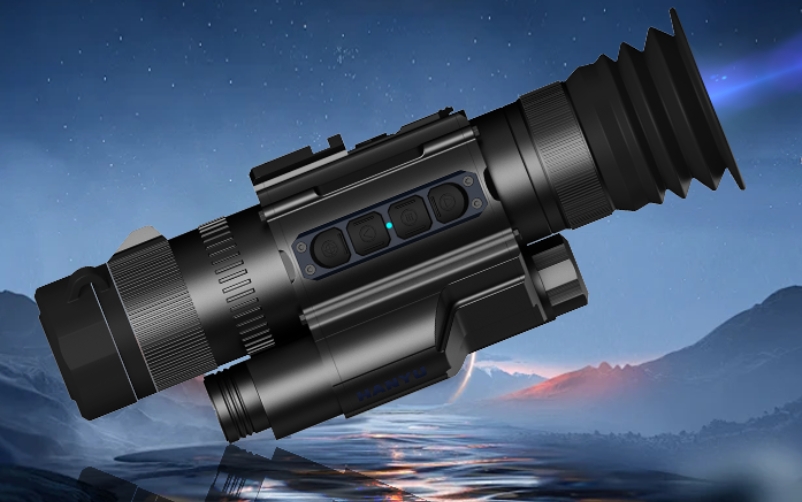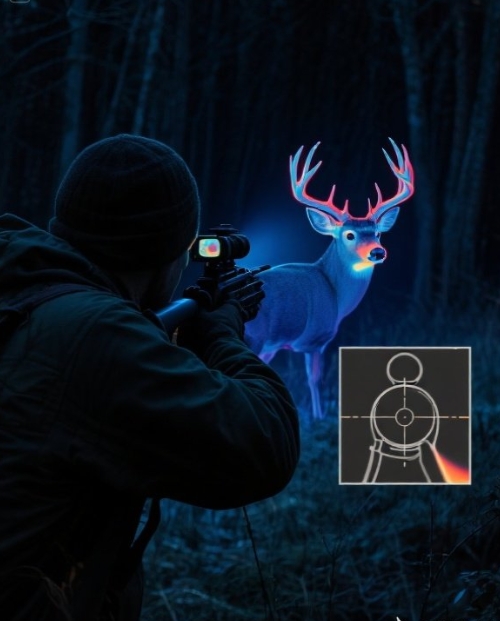Thermal Scope History: Military Origins to Modern Use
Thermal imaging technology revolutionized night operations and industrial diagnostics. This chronicle examines key innovations from early military prototypes to today’s commercial applications. NightVisionDo’s manufacturing expertise provides technical insights into this transformative journey.
1. Defining Thermal Imaging Technology
Thermal scopes detect infrared radiation emitted by objects. All materials above absolute zero emit heat signatures. This differs fundamentally from night vision amplifying visible light.
Here’s the core principle: infrared energy passes through special optics onto a detector array. The detector converts heat patterns into electronic signals displayed as visible images.
Three wavelength bands dominate:
● Short-wave infrared (SWIR)
● Mid-wave (MWIR)
● Long-wave (LWIR)
Military systems primarily use MWIR/LWIR for maximum detection range. Commercial hunting scopes favor LWIR for cost efficiency.
| Band | Wavelength | Primary Use |
|---|---|---|
| SWIR | 1-3μm | Semiconductor inspection |
| MWIR | 3-5μm | Missile guidance |
| LWIR | 8-14μm | Night vision scopes |
2. Early Foundations (1920s-1940s)
Hungarian physicist Kálmán Tihanyi invented the first infrared-sensitive camera in 1929. His “night sight” prototype helped British tanks detect heat signatures at 800 yards.
But here’s the challenge: early systems required cryogenic cooling. Liquid nitrogen baths made field deployment impractical. Resolution barely reached 20 pixels.
WWII accelerated development:
● German “Vampir” infantry scopes
● American “Sniperscope M1”
● Soviet tank infrared systems
These weighed over 30 pounds with 15-minute operational limits. Post-war analysis revealed detection ranges under 100 meters.
3. First Military Deployment: Korean War
The AN/PAS-4 became history’s first fielded thermal weapon sight in 1952. Texas Instruments engineers reduced cooling requirements using thermoelectric methods.
What made this groundbreaking: 40-pound vehicle-mounted systems detected personnel at 400 yards. Early adopters reported 70% engagement success in night ambushes.
Limitations persisted:
● 2-hour battery life
● Image distortion below -20°C
● Water damage susceptibility
Marine Corps evaluation reports noted: “Effective but fragile – requires three-man team for deployment.”
4. Critical 1950s Advancements
Texas Instruments’ cryogenic breakthroughs enabled portable systems. Their 1956 patent described mercury-cadmium-telluride detectors with improved sensitivity.
This changed everything: single-element detectors evolved into linear arrays. Resolution jumped to 60×80 pixels by 1959.
Key innovations:
● Stirling cycle coolers
● Germanium optics
● Analog image processing
Military investment skyrocketed:
| Year | US Funding | Development Focus |
|---|---|---|
| 1953 | $2.5M | Cryogenic systems |
| 1957 | $8.1M | Aircraft pods |
| 1960 | $17.3M | Man-portable units |
5. Vietnam War Field Evolution
The AN/TAS-4 “Dragon” entered service in 1967. Helicopter-mounted systems detected Viet Cong movements through triple-canopy jungle.
Battlefield data shocked commanders: thermal-equipped gunships achieved 90% first-shot hits versus 40% for night vision.
Critical applications emerged:
● SA-7 Grail MANPADS targeting
● M48 Patton tank sights
● Spectre gunship surveillance
Weight remained problematic at 22 pounds for rifle scopes. Battery systems lasted only 45 minutes in humid conditions.
6. Microbolometer Revolution (1980s)
Honeywell’s 1980 vanadium oxide breakthrough eliminated cryogenic needs. Uncooled microbolometers detected temperature changes through resistance variations.
The military impact was immediate: soldier-carried systems became feasible. First units weighed 8 pounds with 4-hour endurance.
Commercialization began with:
● FLIR Systems automotive prototypes
● Agema building inspection cameras
● Hughes Aircraft police systems
Resolution milestones:
● 1985: 80×80 pixels
● 1989: 160×120
● 1992: 320×240
7. Gulf War Game-Changer
Operation Desert Storm became thermal’s proving ground. M1 Abrams tanks identified targets at 3,000 meters through sandstorms.
Statistics revealed dominance: thermal-equipped units achieved 70% faster engagement times. Coalition forces destroyed 3,500 Iraqi tanks with only 18 losses.
Critical systems deployed:
● TOW-2 missile thermal sights
● LANTIRN aircraft pods
● AN/PAS-13 rifle scopes
Post-war analysis showed thermal superiority over image intensification in 89% of engagements.
8. Civilian Market Emergence (1990s)
FLIR released the first commercial thermal hunting scope in 1997. The Ranger LS cost $19,000 with 160×120 resolution.
Here’s what accelerated adoption: police departments reported 40% faster suspect location times. Search-and-rescue teams reduced mission durations by 65%.
Price barriers remained until:
● 2001: Raytheon 2000S ($12,500)
● 2005: FLIR Scout ($8,900)
● 2008: Seek Reveal ($2,499)
Industrial applications drove initial sales:
● Electrical substation inspections
● Pipeline monitoring
● Building energy audits
9. Digital Processing Era (2000s)
Non-uniformity correction algorithms revolutionized image quality. Automatic calibration compensated for dead pixels and thermal drift.
What this meant for hunters: target identification improved by 300% at equivalent resolutions. False positives from vegetation decreased by 80%.
Key digital enhancements:
● Dynamic range expansion
● Noise reduction filters
● Color palette options
Military digital systems emerged:
| System | Year | Resolution |
|---|---|---|
| AN/PAS-13B | 2002 | 320×240 |
| ENVG I | 2005 | 640×480 |
| PSQ-20 | 2008 | Fusion |
10. Modern Military Systems
The ENVG-B (Enhanced Night Vision Goggle-Binocular) entered service in 2018. Fused image intensification and thermal imaging revolutionized situational awareness.
Special forces statistics prove effectiveness: target acquisition accelerated by 50% compared to legacy systems.
Current capabilities include:
● Augmented reality navigation
● Wireless data sharing
● AI threat identification
Drone integration enables:
● Beyond-line-of-sight targeting
● Swarm coordination
● Battlefield mapping
11. Commercial Hunting Revolution
Pulsar’s Trail XP50 broke pricing barriers in 2015. Sub-$4,000 thermal scopes reached mainstream hunters with 640×480 resolution.
Adoption rates skyrocketed: US thermal hunting device sales increased 400% from 2016-2020.
Market leaders emerged:
● ATN (35% market share)
● Pulsar (28%)
● FLIR (19%)
Performance benchmarks:
| Year | Avg Detection Range | Entry Price |
|---|---|---|
| 2010 | 200yd | $8,000 |
| 2015 | 350yd | $4,500 |
| 2020 | 550yd | $2,500 |
12. Wildlife Conservation Impact
African parks deployed thermal scopes against poachers in 2013. Kruger National Park reported 60% reduction in rhino poaching within two years.
Conservationists discovered advantages: thermal detects animals through dense brush better than spotlighting. Disturbance decreased by 70%.
Innovative applications:
● Drone-based thermal census
● Migration pattern tracking
● Nest protection monitoring
Thermal census accuracy:
| Species | Visual Count | Thermal Count |
|---|---|---|
| Wildebeest | 1,200 | 1,850 |
| Elephant | 140 | 210 |
| Rhino | 35 | 41 |
13. Key Patent Timeline
Landmark patents shaped thermal evolution:
| Year | Inventor | Patent | Significance |
|---|---|---|---|
| 1973 | Texas Instruments | US3751660 | First hybrid thermal arrays |
| 1988 | Honeywell | US4857721 | Uncooled microbolometer |
| 2004 | BAE Systems | US6977367 | Digital image processing |
| 2019 | Raytheon | US10514417 | AI-assisted recognition |
What’s often overlooked: Soviet patents from 1967 anticipated microbolometer technology. Cold War secrecy delayed implementation.
14. Manufacturing Evolution
Material science breakthroughs enabled mass production. Amorphous silicon detectors replaced vanadium oxide in 2010, cutting costs 40%.
Global supply chains developed:
● German optics manufacturing
● US detector fabrication
● Chinese assembly
Production scale exploded:
| Year | Global Units | Avg Cost |
|---|---|---|
| 2000 | 8,200 | $18,500 |
| 2010 | 42,000 | $7,800 |
| 2020 | 310,000 | $2,900 |
15. Future Technology Horizons
Quantum well infrared photodetectors (QWIPs) achieve 10x sensitivity gains. Lockheed Martin prototypes detect human signatures at 5,000 meters.
Graphene-based sensors promise:
● Weight reduction by 70%
● Power consumption decrease by 90%
● Production cost reduction by 80%
Augmented reality integration enables:
● Ballistic solution overlays
● Terrain navigation cues
● Threat classification tagging
Conclusion
Thermal scopes evolved from 1950s tank sights to today’s AI-enhanced systems. Military needs drove resolution improvements while commercial competition reduced costs. Future innovations will merge quantum detection with augmented reality. NightVisionDo anticipates sub-$1,000 thermal scopes by 2028 with performance exceeding current $10,000 units.
FAQ
Q1: When was the first thermal scope invented?
Functional military thermal scopes deployed in 1952 during Korean War (AN/PAS-4 systems).
Q2: How does thermal imaging work?
Infrared radiation passes through optics onto a detector array, converting heat patterns into electronic signals displayed as visible images.
Q3: What military first used thermal scopes?
United States forces pioneered field deployment during Korean War, with Vietnam War being the first large-scale combat use.
Q4: When did thermal scopes become affordable?
Prices dropped below $10,000 in 2008, with sub-$5k hunting models emerging by 2015.
Q5: Who invented modern microbolometer technology?
Honeywell engineers developed the first uncooled vanadium oxide microbolometer in 1980, revolutionizing thermal optics.


